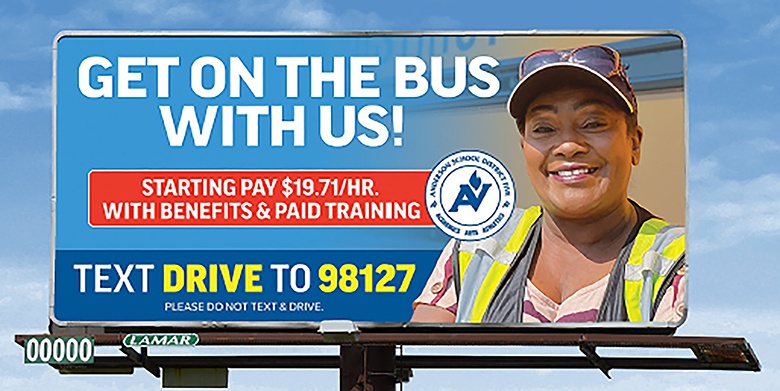
What drives your recruiting efforts? Do you instantly engage with recruits from the moment they think about driving a yellow bus? With a generation absorbed and consumed by cell phones, we must connect with potential applicants quicker now than ever before.
 A few years ago, I was riding with a friend to Atlanta, Georgia, and we stopped at The Varsity drive-thru for a quick bite to eat. As we ordered our food, I saw a sign that read “Text VARSITY to 25000 to apply.” As a naturally curious individual, I whipped my phone out and submitted a text. By the time I received my food a few minutes later, I was already scheduled for an interview that afternoon. This pleasant experience encouraged me to bring this technology to the pupil transportation industry.
A few years ago, I was riding with a friend to Atlanta, Georgia, and we stopped at The Varsity drive-thru for a quick bite to eat. As we ordered our food, I saw a sign that read “Text VARSITY to 25000 to apply.” As a naturally curious individual, I whipped my phone out and submitted a text. By the time I received my food a few minutes later, I was already scheduled for an interview that afternoon. This pleasant experience encouraged me to bring this technology to the pupil transportation industry.
How many times have you spoken with a potential applicant and told them to visit your website, click here, then click there, then scroll midway down the page for a link that will take you to another page to apply? Did you remember to write down their name and contact information so you could follow-up with them? Forget these archaic tactics.
Text NAPT1 to 98127. Go ahead, give it a try. This elementary example proves how easy it can be to get a potential bus driver to your application page. You will instantly have their contact information for follow-up purposes. Immediate engagement with potential applicants is paramount. The options are endless for automated conversations. Like the example earlier with The Varsity, you can even have applicants schedule an in-person or phone interview within minutes.
There are a multitude of options for marketing this automated recruitment process. Having the text line alone will yield no fruit without effective advertising. Frugal options include having principals and teachers send your text line information to parents in newsletters and other correspondences, or printing business cards and sending them home with every student for their parents and grandparents to see. We’ve placed these cards at the front desk of every school and regularly receive job interest from parents and visitors. Cheap and creative recruitment videos can be made for free and advertised at sporting events and on social media. More expensive options include billboards and flashy vehicle wraps, both of which have proven extremely effective in our district.
Social media and word of mouth may be the cheapest and most effective tool. At our in-service training meetings, we have new hires introduce themselves and tell everyone how they found out about the job. Responses such as “the driver of bus 23 gave me the text-to-apply card,” and “the supervisor told me about the job when I called to complain about a late bus,” and “I saw that video on Facebook” are common responses. Our Assistant Superintendent of Student Services, Dr. Jerome Hudson, has recruited several drivers simply by mentioning the job opportunity when he meets with parents.
Many options are available for automated recruiting text lines. I encourage you to consider adding this technology in your recruiting efforts. Build the automated conversations, market appropriately, and watch the applications appear!

Retaining Candidates Throughout the Licensing Process
How many times have you begun the training process with a candidate and lost them to another company before they completed the licensing process? Do you onboard candidates as full-time employees with benefits from the start of training?
We began with a pilot in August of 2022 by hiring unlicensed candidates as full-time Driver’s-in-Training (DIT) at $ per hour less than our starting pay rate. This major change improved our licensing rate by 111% during the pilot. We began the 2022-23 school year with over 30 vacancies. We are now fully staffed with 6 DIT’s in the pipeline and have sustained a 92% increase in the number of candidates whom we retain throughout the licensing process.
Prior to the pilot, we interviewed several applicants who declined the job offer because they could not afford the pay gap during training. At the time, we did not offer employment or pay until the driver was licensed. We all know the licensing process takes time, so why not gainfully employ them during training?
 The competitive training pay rate helped to attract applicants to make the jump from their current employment. DIT’s serve as Safety Assistants during the morning and afternoon routes and train for their CDL during the midday. This pilot proved to be a “win-win” as we had vacancies for Safety Assistants as well. We allow any existing Safety Assistants to enter the DIT program as well if they’d like to pursue gaining their license and becoming a driver.
The competitive training pay rate helped to attract applicants to make the jump from their current employment. DIT’s serve as Safety Assistants during the morning and afternoon routes and train for their CDL during the midday. This pilot proved to be a “win-win” as we had vacancies for Safety Assistants as well. We allow any existing Safety Assistants to enter the DIT program as well if they’d like to pursue gaining their license and becoming a driver.
During the DIT process, candidates often experience riding on the route they will be assigned to drive. This allows the candidate to get to know the students and the route information, making for a seamless transition. Upon completion of the DIT program, drivers are immediately moved up to the starting pay rate so they see an immediate pay increase.
Recruiting and retaining candidates is a challenging task, especially in today’s competitive market. We hope these concepts and ideas can benefit your transportation department positively. Don’t hesitate to reach out to me with any questions!
David Poag is assistant director, transportation, for Anderson School District 5 in Anderson, South Carolina.


